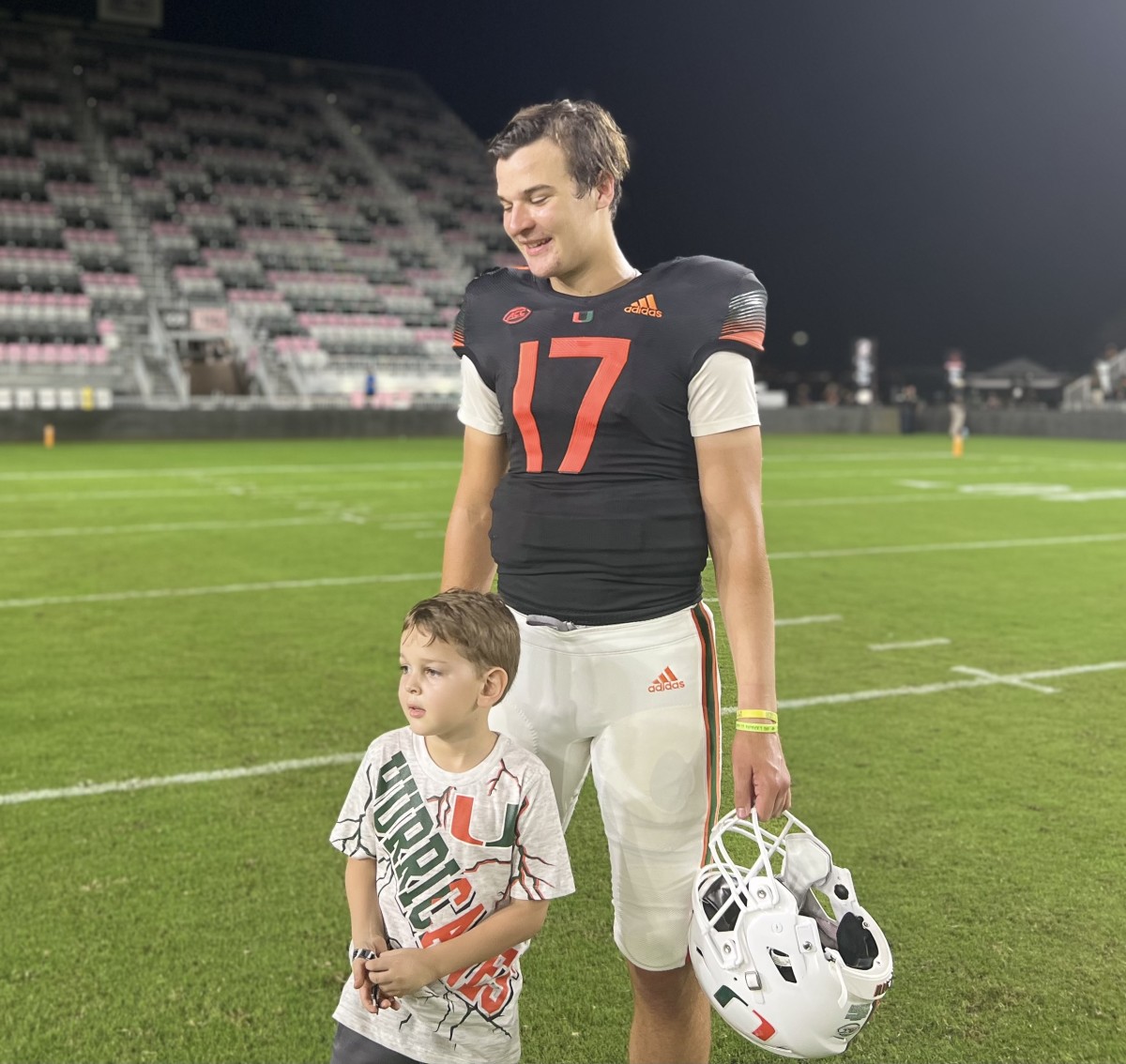How Does Miami Once Again Produce Top Quarterbacks and Win Championships?

To win big in college football, top-notch quarterback play needs to be a part of the equation.
Look at the teams that have at least reached, and often won, the College Football Playoffs from 2016 forward: Clemson with Deshaun Watson and Trevor Lawrence, Alabama with Mac Jones and then Bryce Young, Ohio State with Justin Fields and CJ Stroud, and then Georgia with Stetson Bennett.
They were mostly NFL-level signal callers, and all of them were clutch big-game performers.
We have gone into a new era of college football where scoring points matters, quite frankly. To do that, throwing the football and hitting big plays usually separates one team from the next. That’s where the conversation about Miami begins.
When Miami has produced top-notch teams and been a dominant program, one prime ingredient has typically been a talented passer that often ended up being a NFL prospect.
The long list of big-time Miami quarterbacks most Canes fans resonate with started with Jim Kelly (1978-1982), and it continued on with many others. Bernie Kosar (1982-1984), Vinnie Testeverde (1982-1986), Craig Erickson (1987-1990), Gino Torretta (1989-1992), Ken Dorsey (1999-2002), Jacory Harris (2008-2011) and Stephen Morris (2010-2013) represented several more of the top signal callers for the Canes.
What does Miami need to do to get back to that level? For one, give this next season’s starter, Tyler Van Dyke, as much time to pass as possible. He has some serious talent coming back like Colbie Young and Xavier Restrepo.
The offensive line should be much improved this year, so Van Dyke has a chance at a huge season.
Assuming he heads off to the 2024 NFL Draft, there need to be key steps and making sure that a trend of Miami producing NFL signal callers helps the Canes get back to the top of the college football world, too.
Here are a few of the points that need to be considered, including topics like recruiting, scheme, and development.
1) Sign recruits that fit the scheme Shannon Dawson wants to operate.
With Dawson coming over from the University of Houston, his version of an offensive scheme has components one could argue include any one of a traditional spread, run and shoot, RPO-heavy spread with a running quarterback, and the offense he’s most often tied to, the air raid.
In short, Dawson has adapted over time; he used the quarterback available to make plays best suited to his traits during each season.
That will provide the Canes with a wider girth of options in recruiting. Does it mean just any style of quarterback should be considered in recruiting, however?
Not really. In its truest sense, Dawson’s offenses have been their best when the one known commodity that the vast majority of coaches desire has been available: A quarterback with consistently good accuracy.
The air raid depends on many quick throws to talented playmakers in space. Get them the ball as quickly as possible – while hitting them in stride – to help maximize their chances of keeping their speed while catching the football and eventually making defenders miss.
Sounds simple. Without accuracy, however, even short throws do not work out well.
Now, Dawson’s offenses have used a running quarterback before, so it’s just about throwing the football. He will do it again when he has a signal caller capable of making plays with his feet.

That stated, Miami did quite well to land Emory Williams in the 2023 recruiting class because he’s a consistent passer first and foremost. He’s probably a good model of what the Canes need to sign each year moving forward.
To that point, Miami’s 2024 quarterback commitment, Judd Anderson, has similar traits to Williams. He’s just more inexperienced as a starting high school quarterback than many other Power 5 quarterbacks were at the same stage of development. It will be fun to see what Dawson and the UM coaching staff do with him long-term as Anderson attempts to be a more refined passer. Same deal with sophomore Miami quarterback Jacurri Brown.
2) Sign at least one talented high school quarterback, per recruiting class.
That’s the old axiom. It’s still true today. With the Transfer Portal seeing quarterbacks leave year after year, regardless of school, missing even one year at quarterback (ask the Florida coaching staff - yikes!), can be even more devastating than ever before, too.
Whomever wins the Miami quarterback battle each year, so be it. When one or more of the other quarterbacks transfer – and that will all but certainly happen – again, so be it.
Repeat the process each year. The days of having four or five quarterbacks on the roster during the fall, well, they have become far from a sure thing, at best, because of that same Transfer Portal.
Because of the transfers, three quarterbacks – just like the Canes had last fall – have become far more common. Miami must hit with quarterback recruiting in each recruiting class, period. That’s just to stay at three signal callers during some seasons.
3) Surround the quarterbacks with playmakers.
Much like the quarterback history, Miami’s skill position talent has usually been very good to great, beginning in the early 1980s. If you want to recruit big-time quarterbacks, a part of making that happen starts with attracting top wide receivers, then tight ends and running backs as well.
Those may seem obvious, but also needed to be stated. Quarterbacks like Torretta and Dorsey came to Miami all the way from California. They were highly recruited and could have picked many schools.
Make no mistake, they knew what kind of talent they would be throwing the football when they selected the Canes over several other options. That helped the Canes sign them out of the prep ranks.
Do note as well, Miami’s ability to sign offensive linemen has already been established with the 2023 recruiting class, and that will also certainly help the Canes to build their quarterback room moving forward.
4) Finally, it’s about winning.
This category should be considered as simple as it can be. Top prospects want to play for top coaches and teams. This upcoming 2023 season will be key for Miami not only in getting the 5-7 record off of its back from 2022, but to help set a standard that younger quarterback recruits see and eventually want to be a part of themselves.
If Miami can get back to being a program that goes to a quality bowl game after the 2023 season, the ability to attract elite quarterback recruits will improve. The level of interest will continue to improve each year Miami wins more games and moves up in the rankings.
Think of it this way, Georgia’s offense has still been fairly basic and it just landed the nation’s No. 1 quarterback recruit. Could a team that went 5-7 land Dylan Raiola?
Not likely.
He will go from the Phoenix area all the way to Athens – even with Kirby Smart’s history as a conservative offensive coach – to play for the Dawgs. Winning matters.
Overall, Miami can get back to being a program that consistently produces top quarterbacks and top teams. There will be different ways to get there, but the points above need to at least be a major part of the process.
If Miami starts rolling out NFL quarterback talent once again, there’s also a really good chance Miami’s back in the mix for national titles before all too long as well.
2024 Recruiting Rankings: Florida's Top 25 Prospects
Miami Racking Up Impressive Official Visitor List
5 Prospects Miami Fans Should Know
AllHurricanes.com is your home for all things Miami Hurricanes football, recruiting, basketball and other athletics, all the time. Follow along on social media at @AllHurricanes on Twitter and All Hurricanes on Facebook for round-the-clock news and analysis.
